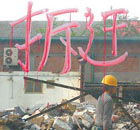Top Biz News
China to set up first national industrial transfer zone
(Xinhua)
Updated: 2010-01-22 13:57
 |
Large Medium Small |
China's government has approved plans to build its first national-level industrial transfer zone to encourage the relocation of low-end industries from coastal regions to inland areas.
The zone is part of a plan to help coastal regions move up the value chain while keeping low-skilled, low margin manufacturers inside China.
Covering 76,000 square kilometers and with a population of 30.58 million, the zone includes 10 cities along the Yangtze River in the eastern province of Anhui, such as Hefei, Wuhu and Ma'anshan. It boasted an annual economic growth rate of 14.8 percent from 2004 to 2008.
The pilot program will help to work out new channels and models for industries transferring to central and western regions, said Shen Weiguo, director of Anhui provincial development and reform commission.
The proposed Industrial Transfer Demonstration Zone in Anhui Yangtze River City Belt, approved by the State Council, requires by 2015 that: its gross domestic product be double the 2008 level; the per capita GDP to exceed the national average; and the urbanization rate to be 56 percent.
The zone will put priority on six industries: equipment manufacturing, raw materials, textiles, high-technologies, services and agriculture.
"We will upgrade infrastructure, public services and support facilities to accommodate large-scale industrial transfers," said Shen.
"The move will also bring business opportunities to overseas investors."
Shen said the zone would encourage Fortune 500 companies to set up regional headquarters and research and development centers, and foreign firms to merge and acquire local firms.
The central government would unveil favorable investment, tax and land purchase policies, Shen said. It would also increase transfer payments and encourage banks to provide credit.
China has seen a surge in industry transfers from coastal regions to central and western areas due to rising costs and resources and environment pressures. Coastal regions are also seeking to move up the value chain.
| ||||
The inland regions boast low costs and huge markets and transfers would help narrow the regional wealth gap, said Hu Zaisheng, head of the Anhui Provincial Economic Research Institute.
"My calculations show that you can reduce costs by 30 percent if you invest here rather than in coastal areas," said Shen.
Job opportunities in the Yangtze River Delta had plummeted due to the shift to modern services and high-tech industries, said Cheng Biding, vice chairman of China Regional Economic Society.
But Cheng said the zone would face serious competition from countries like Vietnam and Cambodia for transferring projects.
The scheme also posed challenges in protecting the environment, ensuring the scientific use of resources and providing social security for farmers who could lose their land due to transfers, said Shen.











